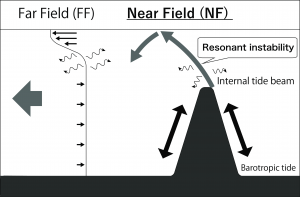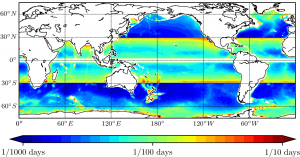Yohei Onuki
Dynamics of internal wave resonance forming tidal mixing hotspots
Research summary
Waves generated in a barotropic tidal flow over bottom topography, so-called ‘internal tides,’ are the most significant energy source in the mid and deep ocean. Dissipation of the internal tide induces diapycnal mixing affecting from regional to global ocean environments. A kind of resonant phenomena among internal waves, known as parametric subharmonic instability (PSI), plays a vital role in the internal tide dissipation. PSI is affected by the rotation of the earth, and its efficiency for the semi-diurnal constituent becomes highest at 29N/S (Figure 1). Observations reported high energy dissipation rates over the Izu-Ogasawara ridge crossing 29N to the south of the Japan islands. A tidal mixing hotspot is expected to be formed in this area.
Ocean mixing associated with internal tide dissipation can be classified into two types: the ‘Near Field Mixing’ occurring near the generation sites of internal tides and ‘Far Field Mixing’ induced by the far-propagating longwave components (Figure 2). Although past efforts are mainly directed to reveal the PSI processes in the Far Fields, the present study investigates the Near Field Mixing induced by the resonant instability arising in the local beam wave emanating upward from the bottom topography. We conduct theoretical analysis for the basic fluid equation and numerical simulation, as well as analyzing observation data, to quantify the mixing intensity over the ridge and to contribute to the improvement of mixing parameterizations implemented in the general circulation models.

Figure 2. Internal tides can be classified into two types: the Near Field component existing in the vicinity of its generation sites, and the Far Field component propagating away with a large spatial scale. This study investigates the physics of resonant instability and resulting diapycnal mixing in the Near Field.

Figure 1. Theoretically estimated resonant interaction intensity for the semi-diurnal (M2) internal tides with the largest wavelength. The numbers under the color bar indicate the time for internal tides to lose their energy; in red areas, resonant interaction occurs most intensively.
Principal Investigator:
Yohei Onuki (Assistant Professor, Research Institute for Applied Mechanics, Kyushu University, Physical Oceanography)
https://www.riam.kyushu-u.ac.jp/omg/index.html.en
Joint Cooperators:
Toshiyuki Hibiya (Professor, Graduate School of Science, The University of Tokyo, Physical Oceanography)
Ichiro Yasuda (Professor, Atmosphere and Ocean Research Institute (AORI), The University of Tokyo, Physical Oceanography)
Naoki Hirose (Professor, Research Institute for Applied Mechanics, Kyushu University, Ocean Modeling)
Yoshimasa Matsumura (Assistant Professor, Atmosphere and Ocean Research Institute (AORI), The University of Tokyo, Physical Oceanography)
Yuki Tanaka (Assistant Professor, Graduate School of Science, The University of Tokyo, Physical Oceanography)
Takashi Ijichi (Researcher, Woods Hole Oceanographic Institution, Physical Oceanography)


